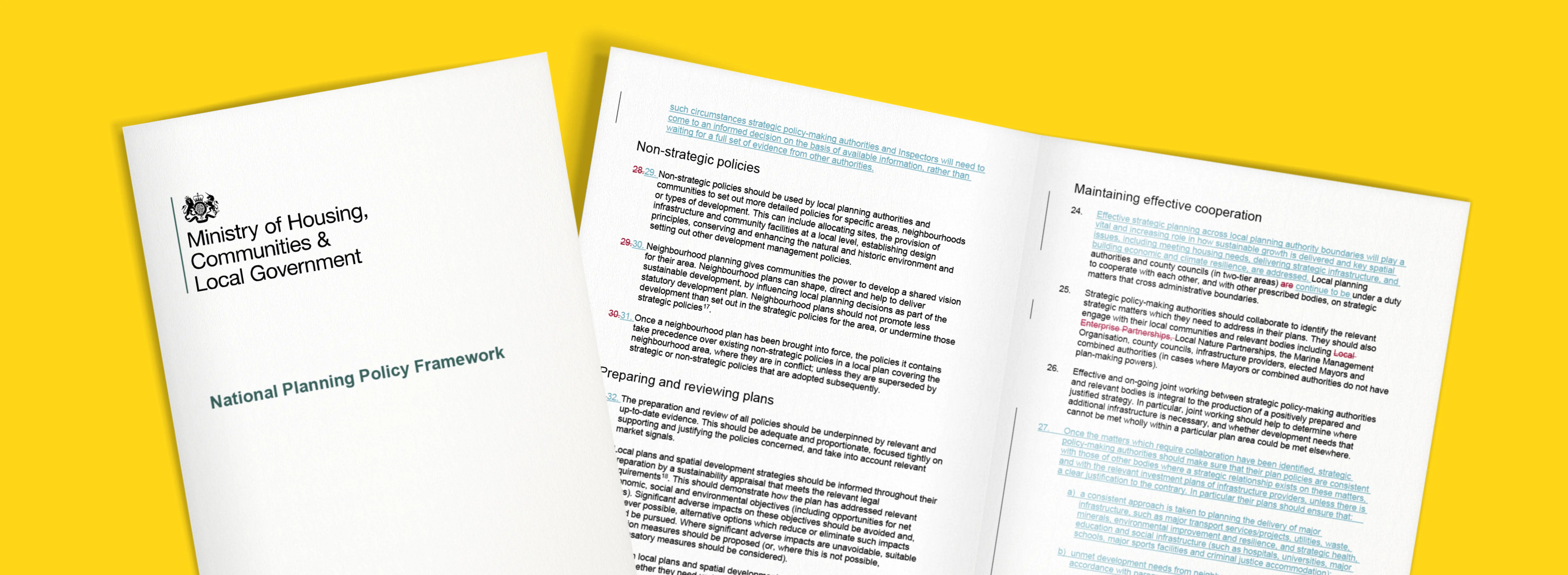Sectors for Sustainable Growth
Homes in Sustainable Locations
A sobering statistic – 2023/24had the lowest number (4,754) of new home completions in Wales since Stats Wales started keeping records in 1974/75
[7]. In the context of increasing housing need and spiralling house prices, the need to boost the supply of housing has never been more critical.
There has been a steady decline in house building activity in Wales over the past 25 years. Average output has fallen by 45% from over 9,200 in the 1990s to 5,110
[8]dwellings in the first four years of the 2020s. By contrast in England over the same period house building activity has increased by 15%
[9]. Despite this fact there are very different messages emerging from Welsh Government and UK government about housing delivery.
Lichfields is concerned that there is national policy vacuum in Wales in relation to overall housing delivery. Whilst there is a target for affordable housing delivery there is no similar policy led target for open market homes. As new housing completions reach an all-time low there is no Welsh Government policy impetus to reverse it or planning policy mechanism to intervene where the plan led system is failing to lead.
The UK Labour government has delivery of a step change in house building as a central pillar of its manifesto. Within weeks of taking power, it has established a challenging housing target for England of 370,000 new homes per annum and re-established the need for local authorities to maintain a five-year supply of housing land.
It will be interesting to see whether the recent changes in personnel at the Senedd together with the strong messages on planning reform from a Labour UK government will result in a closer alignment in approach on housing delivery between England and Wales.
The Competition and Marketing Authority (CMA) recently published a report into housebuilding across the UK
[10]; it included a specific summary paper for Wales. The report raised few surprises:
“too few houses are being built, especially in the areas in which they are most needed, which is having a negative effect on affordability.”
The CMA highlighted evidence of three key concerns whereby the planning system is limiting its ability to support the level of housebuilding that policymakers believe is needed:
Lack of predictability;
Length, cost, and complexity of the planning process; and
Insufficient clarity, consistency and strength of LPA targets, objectives, and incentives to meet housing need.
Since the Welsh Government decided to revoke TAN1 (Joint Housing Land Availability Study) and to remove the five year housing land supply policy in March 2020, the accountability of Local Planning Authorities (LPA) for housing delivery has been severely reduced, with limited (if any) consequence for not meeting LDP housing targets.
The Welsh Government prioritises a plan-led system, in the same way as the rest of the UK. However, this long-held cornerstone of our planning system only works where local plans are updated regularly and without delay. The requirement is that an LPA must review its LDPs no longer than 4 years from the date of adoption
[11]. In reality delays in Local Development Plan (LDP) preparation have been widespread across Wales, with only 7 out of 25 plans being less than 5 years old. Of the remaining 18 LDPs 11 are time expired and therefore fail to offer a robust basis for forward planning.
In the absence of either up to date LDPs or alternative policy sanction there is no incentive to ensure that LPAs are delivering the required amount of housing, no ability to bring forward sustainable housing sites quickly to resolve the situation and limited expectation that the problem will resolve itself in the medium-. The UK government appears to have recognised this issue in England and proposed measures to address it through the reintroduction of the requirement for a five year supply of housing land.
In some quarters it has been argued that the failure to deliver new housing is primarily a result of private sector house builder land-banking. The CMA report finds no evidence of such land-banking in Wales and by contrast acknowledges the need for these house builders to have a ready supply of land given the uncertainties in the planning process.
Increase delivery of Affordable Homes by delivering more open market homes
Welsh Government’s housing planning policy is overwhelmingly focused on affordable housing delivery. Whilst there is clearly a need for increased affordable housing provision this does not need to be an either-or choice by Welsh Government. Increased open market housing building would in Lichfields view enhance delivery of Welsh Government’s primary focus on affordable housing not diminish it.
Lichfields is concerned that Welsh Government’s narrow housing policy approach means that not only are open market housing needs not being properly addressed but that an import source of affordable housing delivery is also being constrained. The consequence is that whilst the proportion of affordable housing delivery may be increasing this is only as part of diminishing overall output.
Welsh Government has a target of delivering 20,000 new low carbon homes for rent 2021 to 2026. Between 2021-2023 WG Affordable Housing Provision data records 6,045 additional affordable homes
[12]. This figure, however, includes acquisition of existing stock so based on Stats Wales Housing Completion data the actual number of affordable new build dwellings was 3,825
[13]. Of these 1,738 (45%) were delivered via s106 agreements from private enterprise schemes.
Lichfields recognises the need for increased affordable housing delivery in Wales but is concerned that Welsh Government is failing to acknowledge the contribution that private enterprise activity plays in contributing to affordable housing delivery. If open market house building rates returned to those experienced prior to the 2008 crash (i.e. in excess of 7,500pa) there would be a significant uplift in associated affordable housing provision complementing the increasing direct provision by RSLs and local authorities.
.
The current low levels of house building are undermining achievement of the seven well-being goals. The planning system has a real opportunity to address these matters and to turbo charge the Wales economy through the house-building sector.
What will help in the short-term?
Whilst Future Wales includes estimates of housing need across the regions it states that these are not a housing requirement for Wales. The affordable element of need contained in the estimates does include a policy aspiration to meet existing backlogs as well as newly arising need however the open market element is purely a trend-based figure. Lichfields considers that there is merit in setting out a policy-on housing target for Wales that provides a proper assessment of need across all tenures as well as sending a signal of the need to increase total housing delivery.
It is understood that Welsh Government is working with LPAs to try and improve up to date LDP coverage across Wales. It is important this work is progressed as a matter of urgency, but the reality is this will take several years. In the interim there needs to be a mechanism for ensuring that house building can not only continue but increase. The re-introduction of TAN1 alongside the reintroduction of the requirement for a five year land supply in PPW would not only address this need but put gentle pressure on LPAs to ensure that up to date LDPs are in place.
Lichfields consider that Welsh Government should
The Welsh Government can issue guidance to LPAs to recognise the acute challenges in the system with regard to housing policy and lack of up-to-date plan coverage in its decision-making. Further, the Welsh Government can choose to embrace the role of the private sector in the delivery of homes by engaging positively with the private sector and through ministerial statements and guidance that treats equally the value of housing delivery from all sources.
Subject to site-specific considerations, local planning authorities should welcome well-considered applications for unallocated sites at planning application stage as an appropriate short-term intervention.
Opportunities should be sought to work positively with those authorities that have housing delivery issues, especially where sites are sustainably located, free from constraints and can demonstrate adherence with Planning Policy Wales’ placemaking principles.
What will help in the medium to long-term?
We urge the Welsh Government to review its approach to housing policy in Planning Policy Wales. Whether this is through the setting of clear national targets that are published every 5 years or by the return of the five-year land supply, this can be explored.
Thriving Town Centres
Over recent years the role and function of town centres has changed dramatically with a decline in traditional retailers. This is in part due to the continued role and rise in online shopping, which has been accelerated by the Covid-19 Pandemic, as well as a desire to combine leisure and food and drink with traditional shopping activities.
In April 2021,
temporary permitted development rights (Classes C-E, Part 4A) came into force which allowed town centre A1 (shops) uses to change to A2 (financial and professional services) uses, A3 (food and drink) uses, B1 (business) uses, D1 (non residential institution) uses or D2 (assembly and leisure) uses for a 6-month period without the need to obtain planning permission for the change of use to support businesses as part of a post-covid response. The Welsh Government indicated that this approach should allow retail and commercial centres to adapt to future retail trends and to continue to meet the needs of local communities.
Whilst a positive proposed shift, they are nowhere near the more flexible approach since introduced in England. The use classes order has been relaxed dramatically with the introduction of Use Class E (commercial, business and service) which encompasses the old A1 (Part), A2, A3, B1, D1 (Part) and D2 (Part) uses. Appropriate restrictions such as for shops of less than 280 sqm that sell essential goods have been retained.
Back to Wales, in an encouraging step, in November 2021 the Welsh Government subsequently consulted on whether to make the temporary changes to permitted development right permanent
[14]. The consultation document stated:
“Prior to the pandemic, there was a growing need to diversify retail and commercial centres so they can adapt to future retail trends and continue to meet the needs of their local communities. This will be even more important as we move forward due to the impact of COVID-19. Numerous vacant units cause demonstrable harm to the character and vibrancy of town centres and have a ripple effect, reducing commercial confidence in the area and its attractiveness to the public. Encouraging alternative commercially viable uses can bring social, economic and regeneration benefits.”
However, 2 ½ years down the line and this change has still not found its way into the regulations resulting in the need for planning permission to be secured prior to a change from A1 to the wider variety of appropriate town centre uses.
The consultation also committed the Welsh Government to a wider regeneration-led review of town centre policy, revisiting the use classes order, Technical Advice Note 4: Retail and Commercial Development
[15] and Planning Policy Wales to determine whether any further steps can be taken to promote greater flexibility in retail/commercial centres to reflect the versatility necessary to maintain vibrant spaces post-COVID19.
Whilst the consultation exercise was welcomed by Lichfields, disappointingly no permanent changes have been made to permitted development rights or the Use Classes Order to promote greater flexibility for town centres since. Likewise, there has been no update to TAN4. A commitment to a Town Centre First approach was made in a
Town Centres position statement published by the Welsh Government in May 2023. This also sought to support a longer term and more joined-up planning of urban centres through planning and cross-governmental actions. Again, little more has been progressed since. We understand that the main barrier is resourcing within Welsh Government, which is frustrating.
PPW is supportive of managing change, but it places an emphasis on local development plans to deliver clear strategies. As we’ve discussed in relation to housing, the vast majority of the adopted LDP’s in Wales are dated, with some, in-effect, time-expired, with policies ill-equipped to tackle the medium and long-term challenges facing town centres. Plan-making is an inherently slow process and short-term solutions are needed to keep up with market changes.
What will help in the short-term?
A clear programme for rolling out the commitments made in the Town Centres position statement, that covered both planning and wider than planning actions.
An analysis of the responses to the use classes consultation and a programme for updating the necessary legislation and bringing it forward without significant delays.
What will help in the medium to long-term?
Empower decision-makers through up-to-date national planning policy and supporting guidance to support proposals that seek to diversify town centres as well as out of centre retail parks through redevelopment and/or repurposing
[16].
Review of local development plans on a regular basis with the need to include sufficient flexibility embedded in policies to respond positively to changing circumstances during the plan-period.
Visiting Wales
Tourism is a critical industry in Wales, employing 1 in 11 of the workforce
The question is whether national planning policy provides the appropriate basis for maximising the economic opportunity from this sector?
The answer is yes, PPW provides a solid support at the national policy level for the tourism sector, requiring planning authorities to provide a framework for maintaining and developing tourism facilities and to enable complementary developments such as accommodation
[19]. PPW recognises the importance of both urban and rural tourism and sees opportunities for both.
Interestingly, at a national policy level the role of airports (in PPW) and ports as service hubs at Holyhead Port, Haven Waterway and Fishguard Port as strategic gateways (in Future Wales) are identified. However, it’s difficult to see how that has been translated into local policy to date.
Future Wales states that for three out of four of Regional Growth Areas, local and strategic development plans should consider existing and potential new tourism areas, the types of visitors they attract and the infrastructure required to support
[20]. Generally local plans in Wales have supportive strategic tourism policies but beyond this, from our experience, the policies are mixed.
Rightly, PPW and Future Wales recognise the need to protect the characteristics of Wales that make it so popular to visitors and indeed those of us who live here too. Careful consideration does need to be given to the scope, scale and nature of new developments when developing policies and preparing planning applications. However, there are also significant opportunities to realise substantial social and economic benefits for local communities while also protecting and/or enhancing the local environment.
There will be circumstances where there is a need to balance sustainability objectives, particularly in the case of rural tourism proposals. We have previously explored the
tensions around short-term lets and housing availability in some areas of Wales. Another example relates to public transport and active travel infrastructure to serve rural tourism, where there is typically poor public transport service, footpaths, and connected infrastructure when compared with urban and suburban areas. Helpfully, PPW recognises this challenge and the transport hierarchy can be applied as a means of working through the most sustainable options where these are available
[21]. There are often solutions to challenges but sometimes it relies on decision-makers needing to make difficult decisions. Robust evidence is needed, while every decision is different.
At its heart, the planning system is about balancing material issues and for the tourism industry this is critical because of the often rural nature of the activities Overall, national policies provide welcome support for growing the tourism sector in Wales and therefore we have a positive starting point for the industry.
What is needed in the short term?
The policy foundations at a national level are positive. Given the value of the industry to the Welsh economy and to the social well-being of local communities up and down the nation, there is an opportunity for the Welsh Government to make statements around the value of tourism to the economy which could be used to demonstrate unambiguous support for positive decision-making at the local authority level, and to adopt the same when making call-in decisions.
Attracting private investment will be critical to supporting the development of the tourist industry in rural and urban areas and we know that operators would be keen to engage where there is a will to explore opportunities.
What is needed in the medium to long-term?
Looking closely, there appear to be some missed opportunities such as those linked to the service hubs; a more joined-up approach may be needed across wider Welsh Government departments to unlock the challenges and to ensure that these national policies are translated into local policies at plan review stage.
A world leader in renewable energy technologies
Future Wales (The National Plan 2040) notes that 29% of the country’s greenhouse gas emissions came from energy supply in 2018. Future Wales notes that Wales can become a world leader in renewable energy technologies. It states:
“Our wind and tidal resources, our potential for solar generation, our support for both large and community scaled projects and our commitment to ensuring the planning system provides a strong lead for renewable energy development, mean we are well placed to support the renewable sector, attract new investment and reduce carbon emissions.”
This is a bold statement, and we welcome the emphasis on ensuring that the planning system provides a strong lead for renewable energy development. Policy 17 of Future Wales is the key policy, setting out that the Welsh Government strongly supports the principle of developing renewable and low carbon energy from all technologies and at all scales to meet our future needs. It states that decision makers must give ‘significant weight’ to the need to meet Wales’ international commitments and the target to generate 70% of consumed electricity by renewable means by 2030 in order to combat the climate emergency. Reference is also made to reducing barriers to the implementation of new grid infrastructure.
Whilst Policy 17 is very supportive in principle, Policy 18 sets out a number of criteria that development proposals need to meet. The overarching positivity of Policy 17 is seemingly lost when considering all the other material considerations that need to be considered through Policy 18. This lack of certainty has been evident in recent ministerial decisions involving large scale solar proposals. For example, in September 2021 a ministerial decision
[22] overturned an inspector’s recommendation for approval of a 125mw solar panel scheme near Marshfield, Newport. The Ministers disagreed with the inspector and considered there was an unacceptable adverse impact on the landscape in relation to Policy 18 of Future Wales.
A resubmission of this scheme
[23] was also recommended for approval by a PEDW inspector but overturned by the minister in July 2023. On this occasion the Ministers noted that the applicant had not followed the stepwise approach in relation to biodiversity and had considered a search area based on grid connection as the primary consideration, which seems a reasonable starting point given the wider challenges for access to the grid. However, this ministerial decision was quashed by the High Court on 19 October 2023 and remitted to the Welsh Ministers for redetermination. A revised decision is awaited. Welsh Ministers conceded the case before the judicial review was considered in court.
In the interim, a letter
[24] to Chief Planning Officers from the Minister for Climate Change (1 March 2022) introduced more confusion into the matter when it confirmed that ‘considerable weight’ should be given to protecting best and most versatile agricultural land (BMV) from development, because of its special importance and unless other significant material considerations indicate otherwise it will be necessary to refuse permission for solar development that is on BMV land. Confusingly, ‘significant weight’ is to be afforded to the need to deliver renewable energy projects but ‘considerable weight’ to be given to the need to protect BMV agricultural land.
Whilst there is strong support in principle for renewable energy schemes it seems that this is not coming through in decisions with the ‘significant weight’ required by Policy 17 of Future Wales seemingly being outweighed by other considerations such as biodiversity and agricultural land. Whilst biodiversity and BMV are important considerations, clarity and certainty is required to allow investors in renewable energy to have certainty that schemes in Wales will be positively considered. There is often a way forward through such technical issues but these sensible conversations are often hindered by apparent black and white policy positions that decision-makers are forced into taken.
Grid stability and associated development
As previously set out, Future Wales seeks to reduce barriers to the implementation of new grid infrastructure. PPW (paragraph 5.7.8) also states:
“in certain circumstances, additional electricity grid network infrastructure will be needed to support the Pre-Assessed Areas in Future Wales, but also new energy generating developments more generally.”
Lichfields has been involved in numerous grid stability and grid improvement projects ranging from synchronous condensers to battery storage to electrical substations. In our experience there is a lack of understanding of these types of applications in terms of their importance in moving towards a low carbon society. The Welsh Government should also be cognisant of the fact that these types of developments normally need to be in close proximity to existing electrical infrastructure, otherwise long inefficient connections would be required. We encourage the Welsh Government to emphasise the value of these projects has in PPW and Future Wales because these types of developments are crucial in allowing the grid to be prepared for the transition to renewable energy.
What can be done in the short term?
Significant infrastructure projects will almost always come with policy challenges that need to be overcome – and more often than not a balance needs to be struck. Often there are ways to minimise, mitigate and compensate harms. If Wales is to become a world leader in renewable energy then clearer and consistent guidance is required to provide certainty to local communities, decision makers and those looking to invest in the provision renewable energy infrastructure. These can be announced in the short term through mechanisms such as the Dear CPO letters, a revised Future Wales and/or Infrastructure Policy Statements.
What can be done in the medium to long term?
A full review of the effectiveness of the restrictive BMV policy is needed. This should focus on both large scale agricultural land of Grades 1, 2, and 3a but also to smaller parcels of ‘left over’ BMV land that has limited value to farmers and to food production. However, we know LPAs are finding it difficult to challenge a make contrary decisions in the context of black and white national policy. Any flexibility around smaller parcels should be given to all uses that provide economic benefits – and not just to meet renewable energy development needs.




